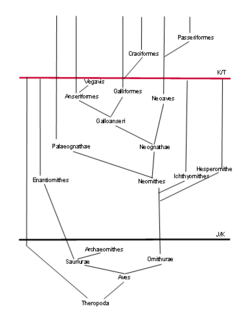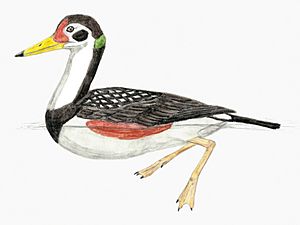Vegavis facts for kids

Quick facts for kids Vegavis |
|
|---|---|
 |
|
| Life restoration based on the 2017 study by Angolín et al. | |
| Scientific classification | |
| Genus: |
Vegavis
|
| Species: |
iaai
|
Vegavis was an ancient bird that lived a very long time ago, about 66 million years ago. It lived in a place called Antarctica, which was much warmer back then! This bird is now extinct, meaning it no longer exists. Scientists believe Vegavis was related to modern-day ducks and geese.
Contents
Discovering Vegavis
The fossil of Vegavis was found in Antarctica. This discovery was very exciting for scientists. It showed that some bird groups we see today were already around. They were living on Earth even during the time of the dinosaurs.
Where the Fossil Was Found
The Vegavis fossil was found in rocks on Vega Island. This island is off the coast of the Antarctic Peninsula. The fossil is kept safe at the Museo de La Plata in Argentina. It is a very special and delicate fossil.
How Scientists Studied It
The bird's remains were stuck inside a rock. To study them without breaking them, scientists used a special method. They used CT scans. A CT scan is like an X-ray that takes many pictures. These pictures are then put together to create a 3D image. This helped scientists see the bones clearly. They could learn about the bird's structure without harming the fossil.
Why Vegavis is Important
Vegavis is a very important fossil. It helps us understand how birds evolved. Before this discovery, scientists were not sure if modern bird groups existed during the Cretaceous period. The Cretaceous period was the last part of the Mesozoic Era. This era is often called the "Age of Dinosaurs."
Proof of Ancient Birds
The Vegavis fossil gave scientists strong proof. It showed that birds similar to ducks and geese were alive 66 million years ago. This means that many different types of birds were already living. They had spread out and developed into different groups. This happened before the big event that ended the dinosaur age.
Bird Evolution
The discovery of Vegavis changed what we knew about bird evolution. It suggests that modern birds did not just appear after the dinosaurs died out. Instead, they had already started to diversify. This means they were developing into many different forms. They were doing this while dinosaurs were still around.
What Vegavis Was Like
Scientists believe Vegavis looked a bit like a duck or a goose. It probably lived near water, just like its modern relatives. We can guess this because its closest living relatives are water birds.
Its Habitat
Antarctica was much warmer 66 million years ago. It was not covered in ice like it is today. There were forests and rivers. This environment would have been a good home for a bird like Vegavis. It would have had plenty of food and places to live.
What It Ate
Like modern ducks and geese, Vegavis likely ate plants. It might have also eaten small insects or fish. Its beak and body structure would have been suited for this kind of diet.
See also
 In Spanish: Vegavis iaai para niños
In Spanish: Vegavis iaai para niños

